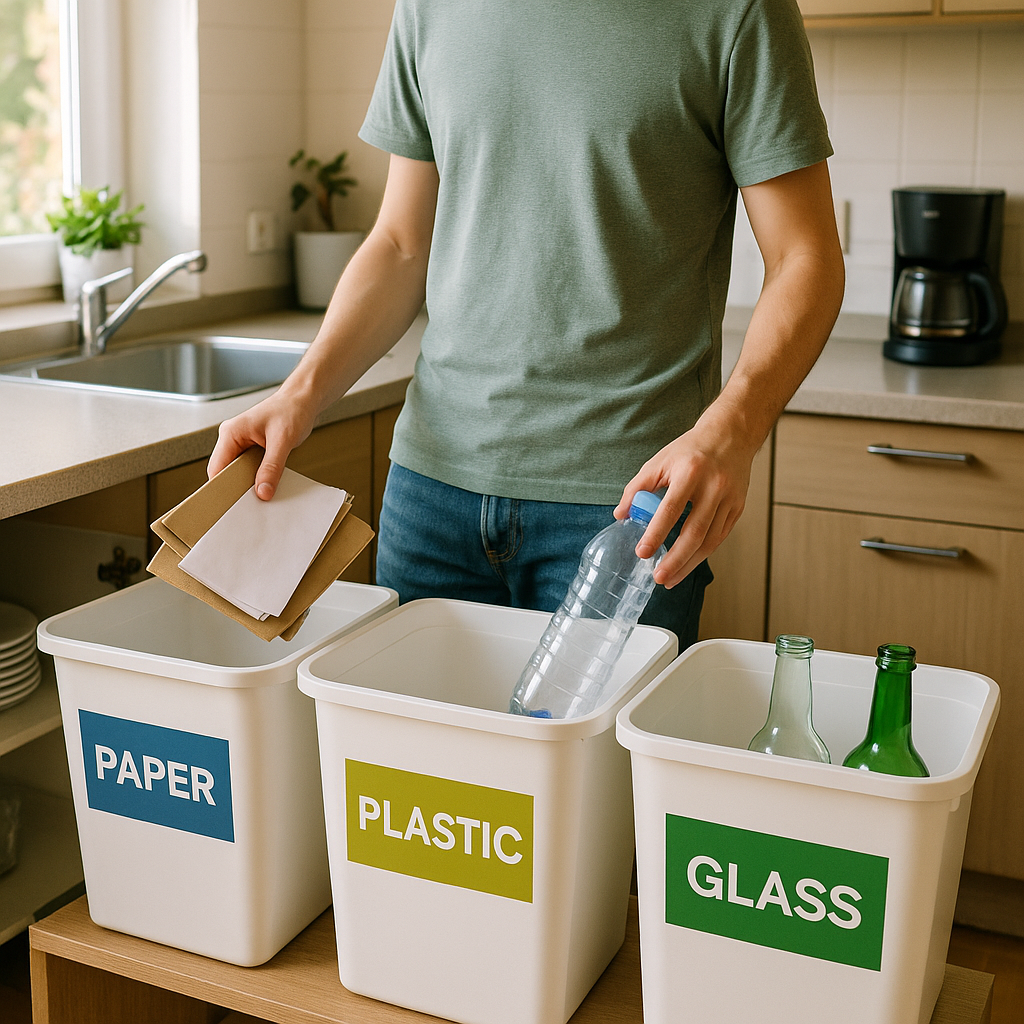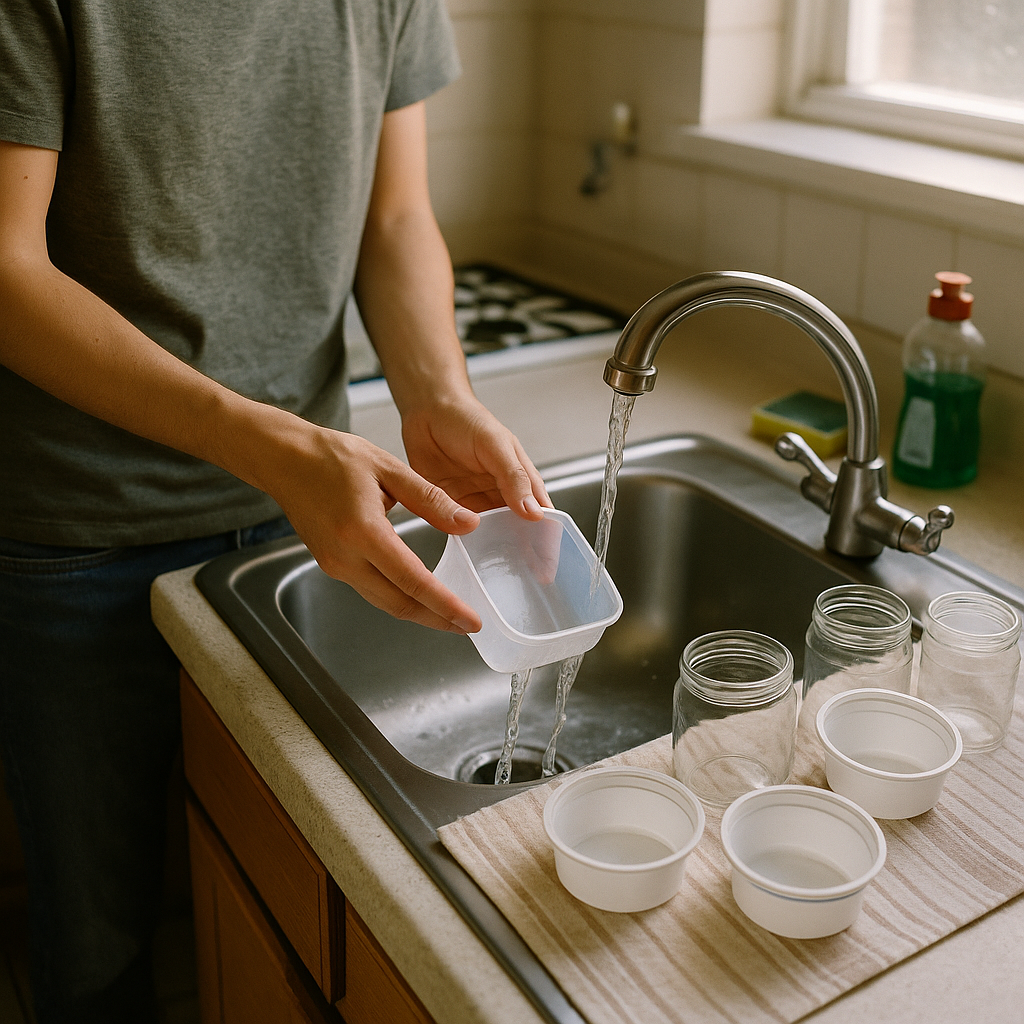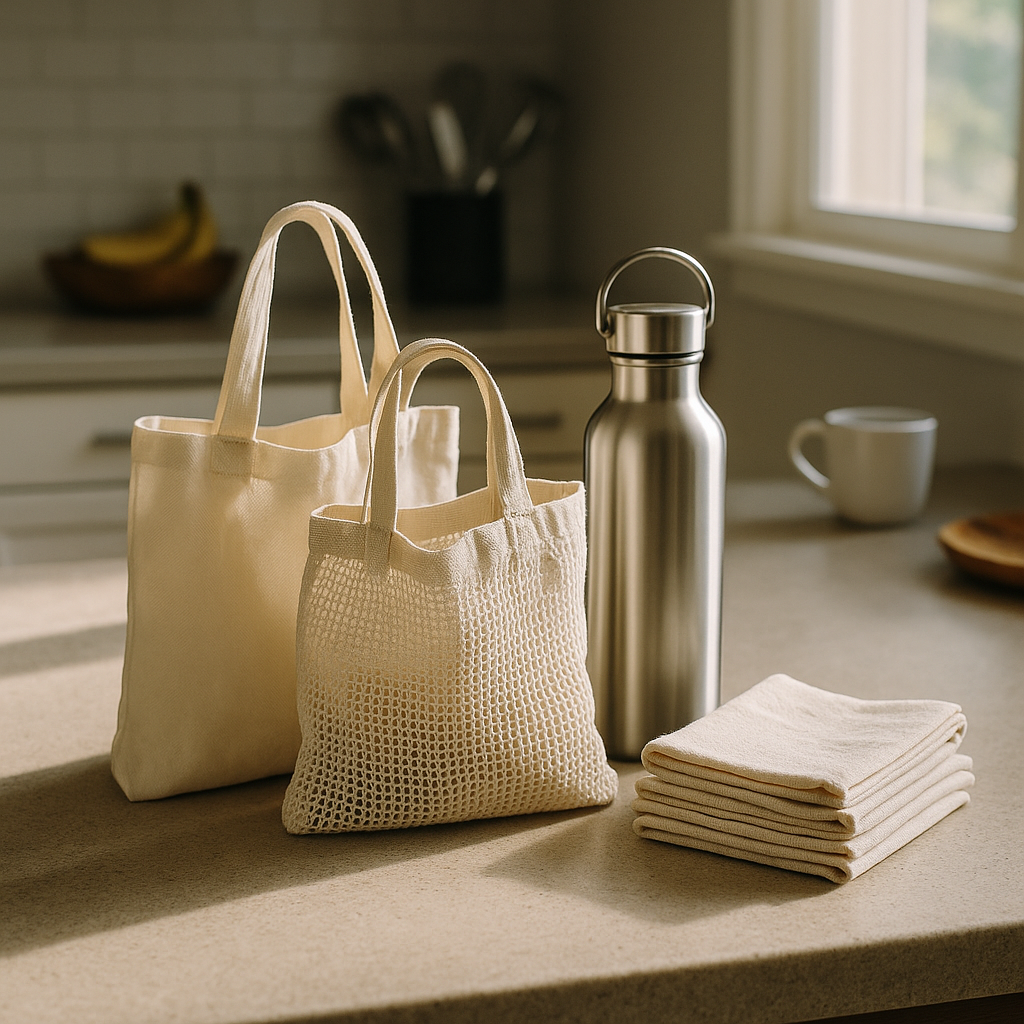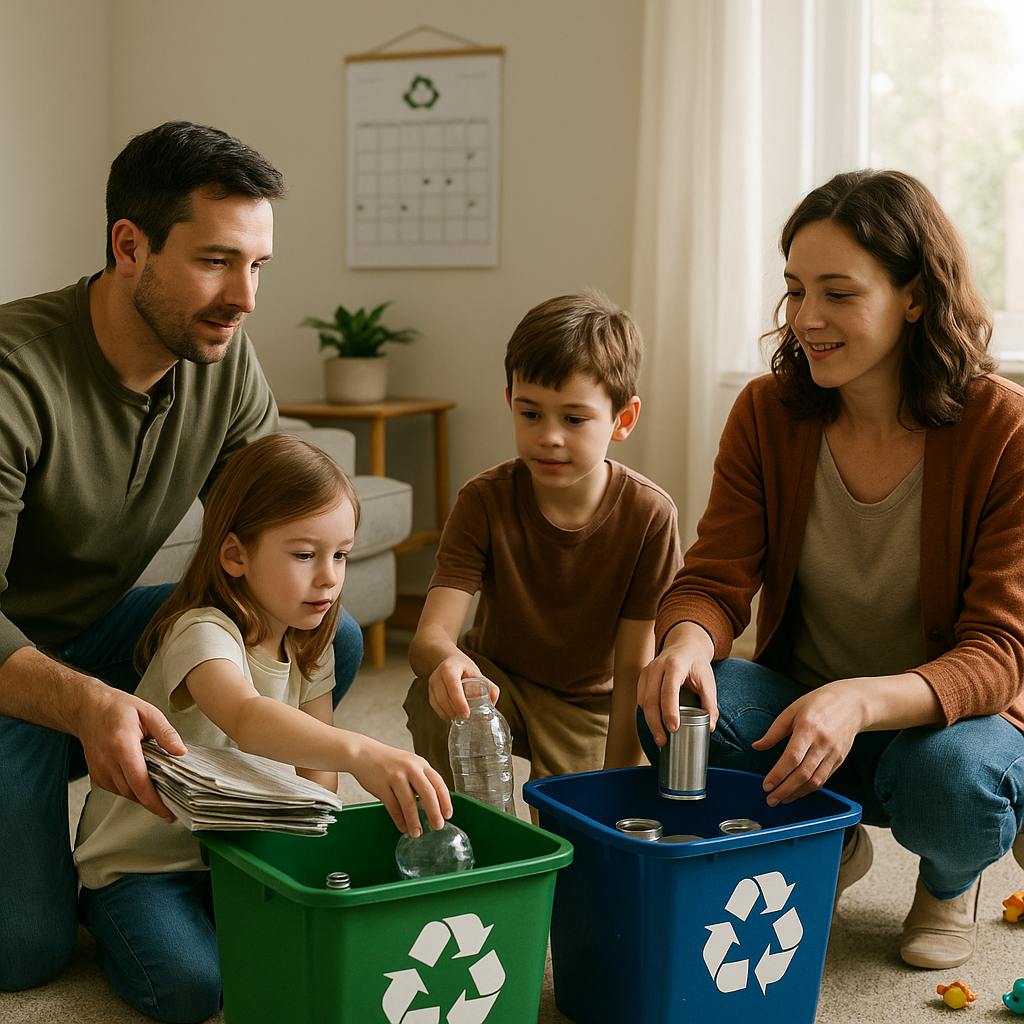5901 Botham Jean Blvd, Dallas, TX 75215
How to Start Recycling at Home: Understanding the Basics
May 20, 2025Did you know the average American generates about 4.5 pounds of waste daily, but nearly 75% of it could be recycled? Effective home recycling can significantly reduce landfill waste. Simply sorting your trash makes a big difference in conserving our planet’s resources.
Recycling at home starts with understanding your local guidelines. Each municipality has specific rules about what materials they accept and how they should be sorted. These regulations ensure recyclables are processed efficiently and prevent contamination that can make entire batches unusable.
Setting up a dedicated recycling station in your home creates a sustainable habit. Place bins in convenient locations for collecting paper, plastic, glass, and metal items. The easier you make the process for yourself, the more likely you’ll stick with it and contribute to environmental protection.
How Do You Set Up an Effective Home Recycling System?

Creating an effective home recycling system starts with thoughtful planning and organization. The right setup can transform recycling from a chore into a seamless part of your daily routine. Strategic bin placement and clear labeling are key in maintaining a successful recycling habit.
Choose a Convenient Location
The location of your recycling station significantly impacts how consistently you’ll use it. Place bins in areas where recyclables frequently accumulate, such as the kitchen or garage.
Keep your recycling bins away from high-traffic pathways but visible enough to remind family members to use them. Position recycling containers next to trash bins to make recycling more automatic when disposing of items.
For homes with limited space, consider using stackable bins, under-sink sorters, or converting a pantry corner into a compact recycling center. Even a small dedicated area can function efficiently with the right organization.
Select Appropriate Containers
Start by assessing your household’s recyclable waste volume before purchasing bins. Consider how much paper, plastic, glass, and metal your family typically generates each week.
Choose bins that are sturdy enough to contain your recyclables without breaking or tipping over. Lidded containers help control odors from food residue and prevent pests from being attracted to your collection area.
For homes with children, select bins with easy-open mechanisms that even small hands can manage. This encourages everyone in the household to participate in recycling efforts.
Create Clear Labels and Systems
Label each container clearly with text and images showing what goes inside. Visual cues help everyone in the household, including young children and guests, sort materials correctly.
Keep a small printed guide near your recycling station listing specific items accepted in your local recycling program. Many municipalities have different requirements, so check with your waste management service for precise guidelines.
Consider color-coding your bins to make sorting even simpler. Blue for paper, green for glass, yellow for plastics, and gray for metals creates an intuitive system that becomes second nature with regular use.
[[artifact_table]] Comparison of Home Recycling Bin Options [[/artifact_table]]Maintain Your Recycling Station
Set a regular schedule for emptying your recycling bins. Overflowing containers discourage use and can create unsightly messes that dampen enthusiasm for recycling.
Rinse containers before placing them in recycling bins to prevent odors and pest issues. A quick rinse removes most food residue and keeps your recycling area clean and sanitary.
Periodically clean the bins with mild soap and water. Fresh, clean containers make the recycling process more pleasant and hygienic for everyone involved.
Review your system every few months to identify potential improvements. Perhaps you need a larger container for papers during tax season or additional bins as your recycling habits expand.
What Can and Cannot Be Recycled at Home?
Understanding what belongs in your recycling bin is crucial for effective recycling. While rules vary by location, several materials are consistently accepted in most curbside programs.
Common Recyclable Materials
Most curbside programs accept plastics labeled with recycling symbols #1 (PET) and #2 (HDPE). These include water bottles, milk jugs, and shampoo containers that should be rinsed clean before recycling.
Paper products generally have high recyclability rates. Newspapers, office paper, magazines, and cardboard can all be recycled as long as they remain clean and dry. Flatten cardboard boxes to save space in your bin.
Glass bottles and jars are infinitely recyclable without losing quality. Rinse them thoroughly and remove caps or lids as required by local guidelines. Some areas require separating glass by color to maintain recycled material quality.
Metal cans, including aluminum beverage cans and steel food containers, are valuable recyclables. Rinse food residue from cans before placing them in your bin. Many recycling programs also accept clean aluminum foil and trays.
Items That Don’t Belong in Your Bin
Several common household items should never go in standard recycling bins. Plastic bags and films clog sorting equipment at recycling facilities. Return these to grocery store collection points instead of placing them in curbside bins.
Styrofoam (polystyrene) products like foam cups, take-out containers, and packing materials are rarely accepted in curbside programs. These materials require specialized recycling processes not available in most communities.
Food-contaminated items significantly reduce recycling quality. Greasy pizza boxes, paper towels with food residue, and containers with significant food waste should go in trash or compost bins.
Items made of mixed materials present challenges for recycling facilities. Coffee cups with plastic linings, juice boxes with foil layers, and flexible packaging often can’t be processed through standard recycling systems.
Understanding Recycling Symbols
The Mobius loop—that familiar triangle of arrows—appears on many products. When paired with numbers 1-7, it identifies the type of plastic but doesn’t guarantee recyclability in your program.
Plastics marked with #1 (PET) and #2 (HDPE) have the highest recycling rates. Water bottles, milk jugs, and detergent containers fall into these categories and are widely accepted.
Plastics labeled #3 through #7 have limited recyclability. PVC (#3), LDPE (#4), PP (#5), PS (#6), and mixed plastics (#7) may require special handling or might not be recyclable in your area at all.
Glass, paper, aluminum, and other materials may have their own specific recycling symbols. The presence of these symbols doesn’t automatically mean your local program accepts these items.
[[artifact_table]] Common recyclable and non-recyclable household items [[/artifact_table]]Local Guidelines Are Essential
Recycling programs differ significantly between communities. What’s accepted in one city might be rejected in another due to different processing capabilities and market conditions.
Contact your local waste management provider or visit their website to obtain specific guidelines. Many provide searchable databases where you can look up individual items.
Some communities offer specialized collection for hard-to-recycle items. Check if your area has drop-off locations for electronics, batteries, light bulbs, or other items not accepted in curbside bins.
When in doubt about an item’s recyclability, it’s better to throw it in the trash. Contamination from non-recyclable materials can render entire batches of recycling unusable.
Proper preparation of recyclables is just as important as knowing what to recycle. Clean containers, remove food residue, and follow local instructions about caps, lids, and labels to ensure your items can be successfully processed.
How Do You Prepare Items for Recycling?

Proper preparation of recyclables is crucial for effective processing. Contamination is one of the biggest challenges for recycling programs nationwide. Following a few simple steps ensures your items can be successfully recycled rather than rejected and sent to landfills.
Clean Your Containers
Residual food waste can spoil entire batches of recyclables. Rinse food and beverage containers to remove any remaining contents. This step prevents contamination and keeps recycling bins odor-free.
A quick rinse with water is usually sufficient for most containers. For stubborn residues like peanut butter or cooking oil, you may need to scrub lightly. The goal is to remove food particles that could attract pests or contaminate other recyclables.
After rinsing, pat containers dry before adding them to your recycling bin. Moisture can damage paper products and create conditions for mold growth, potentially ruining entire batches of recyclables.
Flatten and Compress
Save space in your recycling bin by flattening cardboard boxes and crushing containers when possible. This simple step allows you to fit more materials in your bin and makes transportation more efficient for recycling companies.
Break down shipping boxes along their seams and flatten them completely. For plastic bottles and aluminum cans, compress them by pushing from the top down while maintaining their overall shape for easier identification during sorting.
Large containers like laundry detergent bottles can also be compressed by removing the cap and pressing out excess air before replacing the cap for recycling.
Handle Lids and Caps Properly
Check your local recycling guidelines regarding bottle caps and container lids. Some programs require removing caps from bottles, while others allow them to remain attached.
Metal lids from glass jars typically need to be separated and recycled with other metals. Plastic caps from milk jugs and soda bottles can often be recycled, but the rules vary by location.
When in doubt about specific items, follow the general rule: empty, clean, and dry before recycling. These simple steps significantly improve the efficiency of the recycling process.
Sort According to Local Guidelines
Recycling programs differ between communities, so familiarize yourself with local requirements. Some areas use single-stream recycling where all recyclables go into one bin, while others require separation of paper, plastic, glass, and metal.
Items smaller than a credit card generally cannot be recycled as they may jam sorting machinery. Keep these small pieces out of your recycling bin to prevent equipment damage at processing facilities.
Avoid “wishcycling” – the practice of placing questionable items in recycling bins hoping they’ll be recycled. When unsure if something is recyclable, it’s better to put it in the trash than risk contaminating an entire batch of recyclables.
Special Considerations for Common Materials
- Paper and Cardboard: Keep dry and free from food contamination. Remove any non-paper elements like plastic windows from envelopes.
- Plastic Bottles and Containers: Check for resin codes (usually 1, 2, or 5 are most widely accepted). Rinse and dry before recycling.
- Glass: Only recycle food and beverage containers – not window glass, mirrors, or drinking glasses which have different melting points.
- Metal Cans: Rinse food residue and, when possible, remove paper labels.
For items not accepted in curbside recycling, look for specialized recycling programs in your community. Many grocery stores collect plastic bags, and electronics retailers often accept old devices for proper recycling.
Taking these simple preparation steps ensures your recyclables actually get recycled rather than rejected due to contamination. Your efforts contribute directly to more efficient recycling systems and help maximize the environmental benefits of recycling programs.
How Can You Reduce Waste Beyond Recycling?

While recycling is vital for waste management, there are other effective ways to minimize your environmental impact. Reducing and reusing should be your primary strategies against waste generation. These practices require minimal effort but offer significant environmental benefits.
One simple yet impactful approach is to use reusable alternatives for everyday items. Replace disposable shopping bags with durable cloth options that can endure hundreds of uses. Invest in a quality refillable water bottle instead of buying single-use plastic bottles. Bring your own coffee cup to cafés—many establishments now offer discounts for customers who provide their own containers.
Smart Shopping to Minimize Packaging
Your shopping habits significantly affect waste production. Buying in bulk greatly reduces packaging waste. Items like rice, pasta, nuts, and cleaning products can be purchased in larger quantities or from bulk bins using your own containers. This strategy not only minimizes packaging waste but often saves money.
Shop strategically for items with minimal packaging or packaging that can be easily recycled. Choose products in glass containers rather than plastic when possible. Buy loose fruits and vegetables instead of pre-packaged options. These small choices contribute to meaningful waste reduction over time.
Creative Repurposing of Household Items
Before discarding items, consider their potential for reuse. Glass jars from pasta sauce or pickles make excellent containers for storing leftovers, homemade dressings, or pantry items. Cardboard boxes can be repurposed for storage or shipping. Old t-shirts can be turned into cleaning rags, reducing the need for disposable options.
Donate items in good condition instead of throwing them away. Clothing, furniture, and household goods can find new homes through charity shops, online marketplaces, or community exchange programs. One person’s unwanted item often becomes another’s treasure.
Composting: Turning Food Waste Into Resource
Composting provides a sustainable solution for food waste, which makes up a significant portion of landfill content. The process is straightforward: collect fruit and vegetable scraps, coffee grounds, eggshells, and yard waste, then allow them to decompose naturally into nutrient-rich soil.
Home composting systems range from simple outdoor piles to specialized bins designed for small spaces. Even apartment dwellers can participate using compact indoor composting systems that fit under kitchen sinks or on countertops. Many municipalities also offer community composting programs for those with space limitations.
The benefits of composting extend beyond waste reduction. The resulting compost acts as a natural fertilizer that improves soil structure and fertility. Garden plants thrive with this nutrient-dense addition that helps retain moisture and reduce erosion. Composting creates a closed-loop system where food scraps become the foundation for growing new food.
When you compost, you actively reduce methane emissions that would otherwise occur when organic matter decomposes anaerobically in landfills. This makes composting not just a waste management strategy but also a climate action tool.
Making Reduction and Reuse Habitual
The most effective waste reduction strategies become habitual parts of daily routines. Keep reusable bags in your car or by the door to remember them when shopping. Maintain a small set of reusable containers at work for takeout meals. Set up a simple system for collecting compostable materials in your kitchen.
Track your waste production periodically to identify areas for improvement. This mindful approach helps refine your habits and often reveals surprising sources of unnecessary waste. Remember that waste reduction is a journey rather than an overnight transformation.
By implementing these strategies, you create a significant positive environmental impact. Every item diverted from landfills through reduction, reuse, or composting helps conserve resources and reduce pollution. The collective effect of these individual actions contributes substantially to environmental preservation.
[[artifact_table]] Comparison of Food Waste Management Methods [[/artifact_table]]Conclusion: Making Recycling a Lasting Habit at Home

Starting a home recycling system is a meaningful way to reduce your environmental impact. Setting up an organized recycling station, understanding what can be recycled in your area, and preparing items properly are essential first steps. Combined with waste reduction strategies like avoiding single-use plastics, these actions lay the groundwork for sustainable waste management that becomes second nature over time.
Every item you recycle diverts waste from landfills, conserves natural resources, and reduces pollution. Your consistent recycling efforts, no matter how small, contribute to a cleaner, healthier planet for future generations. For professional guidance on optimizing your recycling practices or assistance with larger recycling needs, contact Okon Recycling at 214-717-4083.
